Choosing an LED lamp for the home e27. Selecting LED lamps: manufacturer ratings and selection rules
Our readers already know that when choosing any LED lamp you should pay attention to the manufacturer. However, we couldn’t find a list of the best manufacturers anywhere on the Internet, so we decided to make this top. So, best manufacturers LED lamps that can be found on our market.
Often people try to save extra money on such a purchase, but many already know that it is best not to trust Chinese manufacturers at all. There is some truth in this, but only a certain amount and no more, there are excellent Chinese manufacturers, and they do no worse than Philips and other foreign brands. At the same time, the cost of such lamps is an order of magnitude less. 
However, despite the high exchange rate, the Chinese LED bulbs remain cheaper, because for some reason even our manufacturers continue to raise prices.
In total there are three main brands:
- European, they have a high cost and good quality. There is only one minus - the cost.
- Famous Chinese and domestic brands. All of them have excellent characteristics, there are disadvantages in assembly and in overestimation of characteristics, but they can be considered acceptable. They have captured almost 80% of the market.
- Chinese from unknown manufacturers. There are a lot of disadvantages here, starting with terrible assembly and ending with low-quality materials with inappropriate characteristics.
If we remember European manufacturers, everything is better here, but the price is always too high, although there are defects in some copies.
If we speak for the best manufacturers of LED lamps, then our resource recommends the second option. After all, in fact, both the price and quality are acceptable. Yes, there are shortcomings, but there are not so many of them.
The third option is not worth considering at all; there are no guarantees, quality, or correct characteristics. They are cheaper, but not so much that you need to choose them instead of the second option.
Choosing a manufacturer
We thought for a long time about how to make the top. Therefore, they collected not only their personal thoughts, but also the opinions of people. The main factor was the price-quality ratio. There are many varieties of lamps and others, each brand has its own, we won’t dwell on this. And so, the best manufacturers of LED lamps, according to experts and people. Now all these manufacturers have started producing
Today, many companies, both Russian and foreign, are engaged in the production of LED light bulbs. In this regard, there is a high risk of buying defective goods, for which you will pay a decent amount of money, because LEDs are the most expensive light source. Next, we will provide you with a rating of LED lamps for the home for 2017, so that you know which companies are best to give preference to when choosing suitable products.
TOP 3 best brands
The Dutch company Philips is rightfully considered the best manufacturer of lighting products in the ranking, including LED lamps. Special attention the brand pays attention to the design of its light bulbs, as you can see by looking at the photo below.
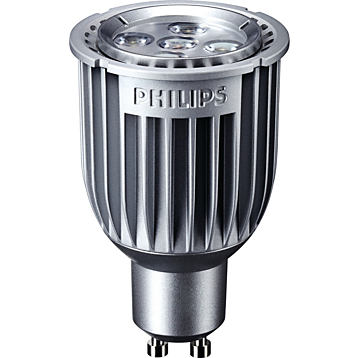
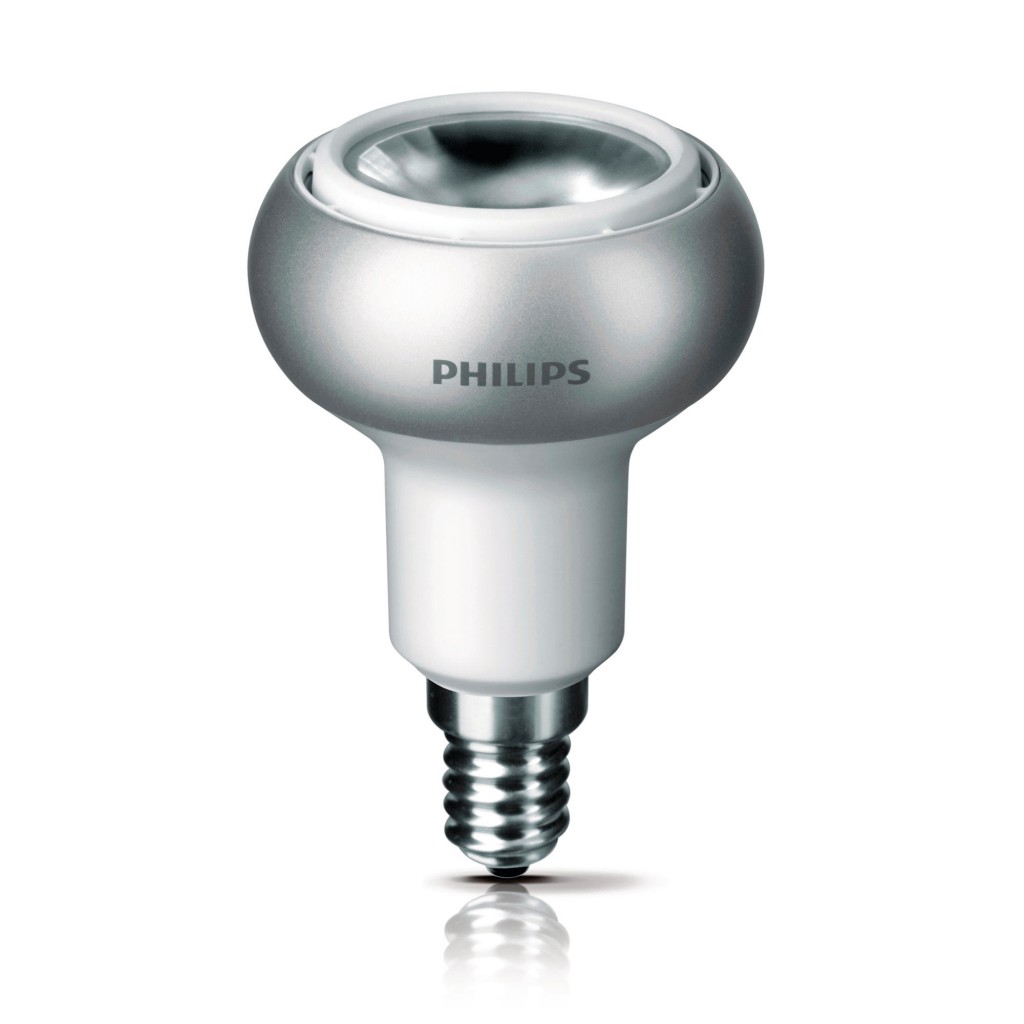
In addition, Philips has done a good job on energy saving properties light bulbs, their service life and, no less important, environmental friendliness. The result is reliable, durable and at the same time economical light sources, which are widely used for LED lighting in houses and apartments. The only drawback of LED products is high price compared to the cost of other leading manufacturers. But still, as reviews on the Internet show, LEDs from Philips already after a year and a half of operation “recapture” their price.
By the way, this manufacturer produces so-called smart light bulbs, which are quite popular today. The Philips Hue model can be turned on and off using an application on a smartphone. In addition, the light bulb can change the brightness of the light and even work as an alarm clock. You can learn more about what they are from our article, in which we also made a rating best models for 2017.
Osram
Second place in the ranking of LED lamps for the home is occupied by products of the Austrian manufacturer - Osram. This brand was tested by the expert organization Stiftung Warentest, as a result of which the products were awarded such merits as: “Longest service life”, “Greatest energy efficiency”, “Environmental protection”. Indeed, Osram LED lamps are considered one of the best in the world, so their use for homes and apartments will be cost-effective. 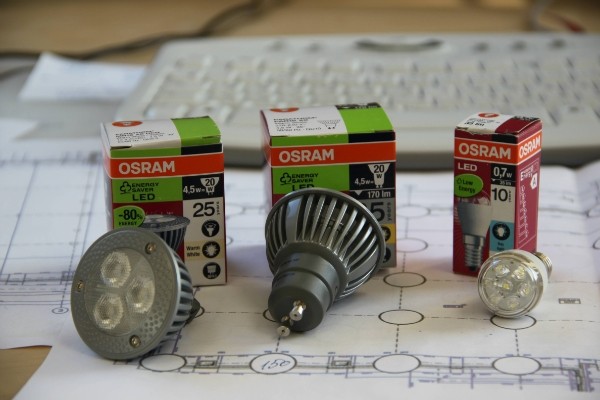
As for the disadvantages, as in the previous case, a huge disadvantage of LED products is high price, which, again, is a controversial issue (for for a long time The work of the light bulb will quickly pay for itself)!
Gauss
The optimum ratio of price and quality
You probably noticed that in the rating of manufacturers of LED lamps for the home, all of the listed brands have one significant drawback- high price. That is why, if you decide to make lighting inexpensive but of high quality, it is better to choose cheaper products. Find out which LED lamps will be no less good for spotlights and chandeliers, you can in this list:
- Optogan (Russia). A domestic company that produces energy-efficient light bulbs with bright LEDs. A good competitor to the Gauss brand, which still made it into the rating, but the price is lower.
- Camelion (China). Fans of Chinese products can use Kamelion lamps in their home, which, oddly enough, are known on the world market and are of relatively high quality.
- Nichia (Japan). Japanese company It has high demand on the Russian market, which can be seen not only from statistics, but also from reviews on the Internet. There is nothing special about Nichia LED lamps, but at the same time, like its competitors in the price/quality category, we can highlight good assembly, high efficiency indicators and an inexpensive price.
Well, finishing our question about which LED light bulbs are best for home and apartment, I would like to talk about those companies whose products have relatively good reliability and low price, but will not be able to get into the rating of the best LED lamps of 2017 with such indicators. For a dacha, in order not to overpay extra money, it is recommended to choose companies such as Maxus (China) and Svetlana-Optoelectronics (Russia). We also recommend that you read comparative characteristics some companies that we have provided in the tables: 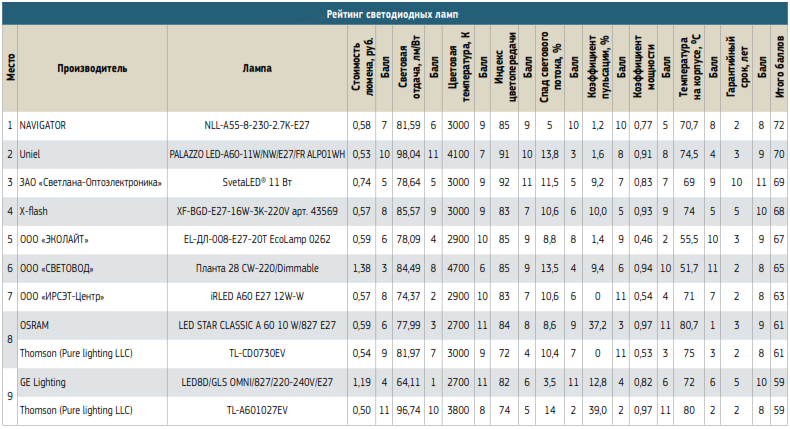

We hope that now you know which LED lamps are best for the home and that our 2017 manufacturer ratings were useful to you! Before purchasing in a store, be sure to make sure that the light bulb is original by visually checking the build quality and warranty period!
Like( 0 ) I do not like( 0 )
What are the best LED bulbs?
We hear this question very often. In order to answer it, you must first understand on the basis of what specific criteria to make such a conclusion? For some, the best lamp will be the one that uses energy most efficiently, i.e. one that “produces” more light per watt of electricity consumed. Why not a criterion? For another person, the best one will be the one that will last longer with the same power. For the third, the best one will be the one that is cheaper than others with the same declared power or light output. At the same time, one must also understand that the service life characteristic (10-20 years) declared by most manufacturers for an LED lamp is only a calculation, since it became possible to buy such LED lamps only a few years ago and not a single lamp has yet been able to prove this in practice. impressive durability.
Thus, to answer the most important question, these criteria must be formed. In our opinion, the manufacturer of the best lamps on the market must:
- have many years of experience under your belt engineering experience in this area;
- when producing lamps, use materials and components that are as safe as possible for health;
- publish honestly and accurately specifications your lamps (all this is very easy to check);
- produce high-quality, neat and informative packaging of products;
- monitor the build quality and ensure stable high level quality regardless of the batch;
- have quality Russian description your lamps (operating instructions inside the package);
- provide a full and long-term warranty for LED lamps and ensure its compliance;
- take care of environment and use materials in production that can be recycled;
- have a website where you can find and download detailed description LED lamps;
- have a full-fledged user support service;
- have high-quality Russian-language catalogs of your products and update them on time;
- have a developed sales network (distributors, dealers, own retail network);
- constantly invest in innovative developments, patent and implement them into production.
We deliberately do not talk about price as a criterion, since the set of qualities indicated above, together with the price of the product, will precisely give each buyer the opportunity to independently determine whether a given price is fair in the presence of such a set of qualities?
In our opinion, the top three leaders of the Russian market are obvious and there are no surprises here - with a significant gap from everyone: Philips (Netherlands), Osram (Germany) and Verbatim (Japan). None of them 100% satisfy ALL of the above conditions, but they definitely have the most complete set of these qualities. The situation is slightly worse for Gauss (Russia), Uniel (Russia), Supra (Japan).
Other Western manufacturers are still Russian market didn't come out. It’s impossible to list them all, but we know that American Cree, Japanese Toshiba, Panasonic and Hitachi, and South Korean Samsung have plans for our market.
Presenters Russian manufacturers It is still difficult to identify among them in the role of catching up and clear leaders, but we are confident that in the next 2-3 years we will have several large and strong manufacturers who will rely on quality and survive in the competition.
Can you trust the characteristics of LED lamps indicated on the packaging?
Unfortunately, not all manufacturers can and should be trusted. Our numerous tests show that only the leading 3 manufacturers are particularly accurate and honest. Others treat these points less scrupulously and act more cunningly, indicating the maximum achievable characteristics in a short period of time and subject to many additional circumstances. This is not written on the packaging, so we consider this to be unfair to the consumer. In addition, self-respecting manufacturers publish methods by which their products are tested, others do not.
Is it possible to buy LED lamps made in China?
Can! As they say, China - China is different! For example, lamps from the first three (Philips, Osram, Verbatim) are also made in China, but at own enterprises, in their own way the latest technologies, on modern equipment and under the close supervision of quality services. Therefore, we recommend that you pay attention NOT to the country of manufacture of the lamp, but to the brand name.
Can LED lamps be used in children's rooms?
Yes, you can. Moreover, it is necessary! LED lamps are significantly safer for adults and children than any other light sources. This topic is covered in great detail in our article “The influence of LED lamps on human health.” It is for these reasons that schools, kindergartens in the United States and Western Europe are actively switching to LED lighting. The sale of incandescent lamps is already prohibited there, and in Russia a similar ban should be adopted in 2016.
Articles about LED lighting
This article is for those who have asked a similar question for the first time and do not have a technical education. LED lightening- this is lighting something using relatively new light sources - LEDs. An LED is an industrially produced crystal that, when connected to electricity, begins to emit light. To be fair, LED cannot be called a new light source, because... it was invented several decades ago, but it began to be actively developed and used in all spheres of our lives only at the beginning of 2000, thanks to new discoveries in the technological field and a significant reduction in production costs.
Modern technologies do not stand still and scientific and technological progress does not ignore such an area of our life as lighting. Development occurs both in the direction of increasing lighting characteristics and in the direction of the emergence of additional related technological devices, increasing the usefulness of lamps and lighting systems in general. We're talking about numerous varieties LED lamps with built-in sensors.
We decided to make a review that will collect the most interesting reviews about LED lamps. We collected these reviews both from our customers (and continue to collect) and from the Internet - from various forums, blogs, thematic portals and other resources. Having received a large amount of data, we systematized it, anonymized it, and we got a certain set of interesting opinions and advice from real people who use LED lamps at home, in the country, in the office, etc.
Customers of our online store often ask questions - which LED lamps are the best, from which companies? Why exactly are they better? Can you trust the characteristics of the lamps indicated on the packaging? Is it possible to buy LED lamps made in China? Can LED lamps be used in children's rooms? These are just some of the questions that buyers ask when choosing the best option for themselves. Moreover, such questions arise when the buyer already knows what type of lamps is needed and with what characteristics. In this article we will try to give answers to all these questions and avoid new puzzles for the consumer :-)
LED is a semiconductor device that transforms electricity into light radiation. LED has a generally accepted abbreviation - LED (light-emitting diode), which literally translated into Russian means “light-emitting diode”. The LED consists of a semiconductor crystal (chip) on a substrate, a housing with contact leads and an optical system. The light emission directly comes from this crystal, and the color of the visible radiation depends on its material and various additives. As a rule, there is one crystal in the LED housing, but if it is necessary to increase the power of the LED or for emission different colors It is possible to install several crystals.
« Which brand of LED lamps is better, better quality, brightest"? This is a question we are often asked by our clients. Having scoured the Internet, we did not find an answer that would satisfy us completely, so we decided to conduct an experiment with subsequent conclusions ourselves. And this is what happened:
The test purchase of lamps in the name of truth took place in January 2015 at various retail outlets in Chelyabinsk and we now have 9 lamps for various manufacturers. All have approximately the same declared power of 5-6 W, warm color - 2700-3000 K. All lamps, except for one Gauss (we didn’t find the right one) type MR-16 - for recessed luminaires.
So. Our test subjects:
1. E14 6 W 2700 K (1 year warranty). The photo shows a box from MR16 Elementary.
2. Estares GU10-9L-220V 5W warm (1 year warranty)
3. Elektrostandart JCDR AL 60SMD LED 5 W 3300K (1 year warranty) The packaging, unfortunately, has evaporated. Lost, basically.
4. 5W 3000K (2 year warranty)
5. Ecola MR16 5.4 W 2800K (1 year warranty)
6. Osram Decostar MR16 35W/12 V halogen, used as a standard
7. Pulsar MR16 ALM-JCDR 5W 2700K (2 year warranty)
8. Foton Fl-led MR16 6W 2700 K (the manufacturer was silent about the warranty)
9. Feron LB-26 7W 2700K (the manufacturer was silent about the warranty)
As we can see, all lamps, except one Gauss (we didn’t find the right one), are of the MR-16 or GU10 type - for recessed luminaires. The Gauss lamp is an E14 “candle,” but by removing the bulb, we got the sample we needed for our experiments.
Of course, there is a possibility that while this article is being written, some lamp model has been replaced with a more advanced and, possibly, higher quality one, but we repeat: all lamps were bought at the same time in popular retail outlets and not from a “illiquid” sale. Thus, it is possible with a high degree of probability to correctly characterize the manufacturer’s attitude towards its brand, and, given the price of the product, towards the buyer, ultimately.
Experiment 1. Determine the lamp with the best color rendering.
For convenience, we install everything in their native rim lamps on the same level with LEDs strictly vertically upward. For the purity of the experiment, i.e. To bring all lamps to equal conditions, we do the following: we cover the exposed LED board for Gauss, and for Osram and Estares, the reflectors with a translucent white plastic diffuser (trophy), thereby making the light as non-directional and diffuse as our other lamps.
We connect all the lamps at the same time. "Oil Painting" below. (Let's make a reservation: unfortunately, the photo did not convey the colors quite naturally, the way we saw them with our own eyes.)
![]()
We compared the glow of each lamp with the Osram reference lamp, the color rendition of which is close to perfect (this is a well-founded point of view of science)
Based on what we saw with our eyes, we made our subjective assessment of the color rendering of each lamp, and you will have to believe it. We assigned the reference halogen maximum number points - 5. For everyone else - less, depending on the similarity of the glow with it and its pleasantness.
Conclusion from what we saw:
| Lamp brand | Gauss | Estares | Elektrostandart | Navigator | Ecola | Osram | Pulsar | Foton | Feron |
|
Colorful temperature according to passport, Kelvin |
2700 | just "warm" | 3300 | 3000 | 2800 | 3000 | 2700 | 2700 | 2700 |
|
Quality control glow, points |
5 | 4 | 3 | 3 | 2 | 5 | 1 | 3 | 4 |
Lamp glow Gauss turned out to be the closest to the glow. Just the right amount of warmth, without pink or other unnecessary shades. The light from the Estares and Feron lamps turned out to be simply yellowish and pleasant. Looking ahead, we will say that this turned out to be the only plus of the Feron lamp. Whether you can use it will depend on how critically you take what is written next.
Lamps Pulsar And Ecola have worse color rendering. The red component in the spectrum is too intrusive. Pink light is not the most pleasant. The glow of the remaining lamps can be considered pleasant, despite the fact that it does not fit into the glow promised from the box of 2700 (like an incandescent lamp) or 3000K (12 Volt halogen, like our Osram) (only “Electrostandard” honestly wrote).
Experiment 2. The brightest LED lamp.
We prefer not to pay attention to what is written on the boxes. Manufacturers promise golden mountains of lumens (the amount of light in them is measured), it seems, based on the maximum light output of the type of exemplary quality LED used, multiplied by their quantity. But LEDs are different, good and bad, bright and so-so.
Let's see with our own eyes and "eyes" special device, which determines the level of illumination in the room. It's called a "lux meter". It is impossible for them to determine the luminous flux of a lamp, the so-called Lumens (Lm), the number that manufacturers deservedly and not very well write on the lamp packaging. This requires sophisticated laboratory equipment. We measured the illumination from each lamp with our lux meter. In all nine cases, naturally, at the same distance and position relative to vertical axis lamps Simply put, at the same point. And under the same night conditions.
Below are the illumination indicators, which is measured in lux (not to be confused with the luminous flux from the box!).
| Lamp brand | Gauss | Estares | Elektrostandart | Navigator | Ecola | Osram | Pulsar | Foton | Feron |
|
Lamp power according to your passport |
6 W | 5 W | 5 W | 5 W | 5.4 W | 35 W | 5 W | 6 W | 7 W |
|
Promised by the box analogue of a halogen lamp |
50 W | 50 W | no info | 35 W | 55 W | 35 W | 50 W | 35 W | no info |
|
Illumination, Lux |
800 | 780 | 420 | 730 | 640 | 880 | 650 | 750 | 430 |
What we have here:
The brightest is our Osram reference halogen. The closest to her were Gauss, Estares, Photon and Navigator. Lamps of the Feron and Pulsar brands close the standings in this competition.
You can object with the words: “But the Gauss power is 6 W, of course it will be brighter.” Yes, Gauss is more powerful (according to the passport) initially. But is it really more powerful? More on this in the next experiment.
This experiment was done for the sake of one more conclusion - to check the honesty of the information indicated on the lamp packaging about its equivalent power to a halogen lamp. You yourself see the whole picture of the state of affairs - everyone lies, some lie more than others less. The tested LED lamps, without exception, did not even reach the brightness level of a 35 W halogen lamp, and there is no need to talk about the equality promised, for example, by the Pulsar with a 50 W halogen lamp.
Foton and Navigator were the most modest and lied the least. People's Choice Award for this.
An important point: the prize for brightness can be selected after a “doping test” in the following experiments. Don’t run to the store to buy the “best lamp”. Read to the end, let's draw conclusions together.
Here we move on to the most interesting sections - with trepanation of lamps, with real measurements designed to determine the safety and durability of LED lamps.
Experience 3. Safety of LED lamps regarding electric shock to humans.
We open all the lamps, taking out, somewhere carefully, and somewhere mercilessly breaking out (in the name of science we will break even the wrong ones) diffusers and reflectors (Estares), getting to the LED boards and giblets, called by some drivers, by others power supplies, and some even transformers. Let’s not quarrel between them, let’s just call the electronic giblets “BP”.
Once said and done, we see:

Hmm..... Feron And Electrostandart, this is unforgivable!
According to our requirements Russian rules safety, the aluminum conductive body of these lamps implies special reinforced (double) insulation of the power supply and supply wires (electronic “guts”, for those who have forgotten). The wires and power supply (from Feron) do not have such insulation. In case of poor-quality soldering, crooked assembly, vibration, etc., a wire torn off from the board, the power supply element ends up on aluminium case lamps. The lamp is inserted into a steel (conducting current) lamp, which in 99% of cases (are your lamps real Italian!?) does not provide protective grounding.
Question to the brand owners: WHY? How they let something like this go on sale, how the certificates were made, is clear to everyone - in Russia so far only school teachers are imprisoned for bribes.
Let's think like this: Russian managers Ferona And Electrostandard They don’t know Russian rules. And in China there are too many people, there are probably no life safety rules, traffic rules and mandatory fluorography and, in principle: “don’t feel sorry for anyone, no one...” . Further on in the course of the experiment, these two brands will be considered by us simply as “extras”. In the competition for the title " best lamp"They are no longer involved.
All other brands have a plastic non-conductive housing, or a part of it in which the power supply is hidden, and the LEDs are covered with an insulating plastic diffuser. It is safe.
Experiment 4. The impact of LED lamps on the organs of vision and general well-being of a person.
British scientists have found that factors such as illumination level, color rendering, color temperature and light pulsation greatly influence our performance, emotional state and, as a result, well-being in general through the eyes.
The brighter or whiter the light does not mean it is better. Each lamp has its own purpose, place and time. But with the pulsation of light everything is simple. The more noticeable it is, the worse it is for our eyes and, therefore, for us in general. Ripple - blinking of light, clearly noticeable by the eye on "soviet" fluorescent lamps in our offices and government agencies. And also in the entrance lamp, where 10 years ago your dad installed a diode so that Ilyich’s lamp did not burn out.
But the examples above are for you to understand that there is pulsation. In the vast majority of cases, even closely observing the lamp in the lamp, we do not notice this vibration of light. Nevertheless, it is there.
Modern requirements of GOSTs and SNiPs regulate this very pulsation for non-residential premises without intruding into your personal life at home. We will not go into details and we will simply say in numbers and formulas: in an LED lamp there is always a pulsation of light. BUT: depending on the type of PD, from uncomfortable, dangerous to absolutely miserable, safe. The more complex the power supply circuit, the more elements it contains, the less this ripple and, accordingly, the safer the lamp is for the eyes. If you type on a computer, read, sew, cross-knit, or weave nets, e.g. your work requires close visual attention - your lamp must be equipped with lamps with modern “correct” power supplies. For all other “pass-through” rooms there are no strict requirements for light pulsation, and therefore for the power supply circuit.
So how can you identify a dangerous block “with pulsation” from a safe one? Look at the photos of the power supply of our experimental lamps.
![]()
A safe circuit has a yellow cube in its design - a choke or a transformer (the latter looks the same). Both of these make us understand that this circuit supplies the LEDs with a very high frequency current. So high that the device, much less the eyes, skin, nose, etc., does not detect the pulsation (blinking) of light.
Lamps Gauss, Estares, Navigator, Electrostandart And Ecola have this choke or transformer. There are essentially no pulsations. There won't be a nervous breakdown :)
Lamps with such circuits should properly have an inscription on the box that says something like “pulsation coefficient” or simply “pulsation” less than 5%” (the threshold from which the lamp begins to be considered dangerous to the eyes) or even simpler “without pulsation.” But since there are no regulations on pulsation for residential premises, such an inscription on the packaging of our lamps is completely optional, and those manufacturers (of our experimental ones only Gauss) who apply it do so only in order to increase sales to those who know about it .
Lamps Feron, Foton, Pulsar They work using a cheap circuit for powering LEDs with rectified voltage. This scheme is not bad because it is cheap. And, of course, the price of these lamps should be cheaper than others. But these lamps should be used exclusively in “passage” rooms - corridors, bathrooms, dressing rooms, etc.
P.S. For those who are "in the know".
At the lamp Foton The filter capacitor capacity is the smallest - 1 mF. All others have 3-4 mF.
Helpful advice: For the majority who are not going to open the lamps to look for “yellow cubes” there, but are concerned about the safety of their family’s health, we can offer this option: take a camera (digital, of course) and look through the viewfinder at the lamp in focus mode. If you see “flashes” of light, the pulsation is significant.
Experience 5. Reliability, service life of LED lamps.
Low energy consumption, reliability and, most importantly, a gigantic service life - this is what we count on when we buy an LED lamp and pay for it many times more than for a regular Ilyich lamp. It would be a great shame to be disappointed after just half a year, as often happens with energy-saving spiral-type lamps.
The reliability of LED lamps, and, in principle, all LED lamps, depends on the following conditions:
The quality of the LEDs themselves, their soldering;
The thoughtfulness of the circuit, the quality of electronic components and the assembly of the power supply;
Proper design of the lamp housing, providing the required heat dissipation from the LED panel;
External factors: network voltage quality, temperature regime in which the lamp is used (literally: so that it does not stand in a bathhouse and is not baked in the sun in operating mode).
Failure to comply with at least one of these conditions leads to premature failure of the lamp. A lamp may have amazingly efficient LEDs, but what's the point if.....well, you get the idea, anyway.
We also tried to check our experimental lamps by one more parameter: “overloading” the LEDs with ultra-high currents. An LED can be made to glow brighter by applying more current to it than it is designed for. But it was not possible to draw a full conclusion. Data sheets for the type of LEDs used are not included. It's a pity! This was very helpful.
We also cannot say anything about the quality of the LEDs themselves in all lamps; we do not have microscopes. It's possible that different brands lamps have the same type of LED (5630 for example), but one manufacturer buys a high-quality and expensive LED, and the other buys a cheap and bullshit one. But they look the same.
We can assume that Feron and Electrostandard use obsolete 3528 LEDs with low light output. All other lamp brands switched to new type LEDs 2835 and 5630. LEDs of this type require fewer quantities, respectively, fewer solder connections, and any connection is a “weak point” with loss of “signal” - voltage and power (you overpay for this, look above at the brightness of these lamps). Gauss, Estares and Pulsar lamps have the smallest number of LEDs, and accordingly the reliability of the board itself with diodes is higher.
There are essentially two types of LED lamps: without a yellow choke cube (transformer) and with it. The first option is much simpler, clearer and cheaper. Perhaps even more reliable than the second one, given the fact that the quality of the electronic components used is unclear.
However, we live in the 21st century. The time of gram records and spinning is in the past. The option with a pulsed high-frequency LED power supply circuit (the second option with a yellow choke) is better, because this principle provides a stable required current through the LEDs, even if the voltage in the network changes or is higher than the nominal 220-240 V. This is very important - do not allow the diode to overheat from increased current flowing through it.
The lamp body, as mentioned above, is also a factor affecting the life of the lamp. The design of the case should be designed taking into account the ability to effectively dissipate the heat generated by the LEDs, and it is very decent. Why remove heat? Then, the lower the temperature of the LED, the longer it shines just as brightly.
There is one more important point, related to the temperature inside the lamp housing: electronic components The lamp power supply also cannot withstand high temperatures.
Thus, the faster with outside the lamp body heats up, the better for it. This means that heat is dissipated well. After all, a good, working thermos is always cold on the outside, as it accumulates heat and does not allow it to escape.
Our lamps have following types buildings.
Aluminum. (Feron and Electrostandard lamps). Everything would be fine if it were not for the danger of being killed by such a lamp. Fail.
Single-layer plastic. (Photon lamp). Heat removal is very difficult. The service life of the power supply is the shortest, the degradation of LEDs (a drop in their brightness over time) is the fastest. Rating "ud".
Double-layer plastic, internally reinforced with aluminum (Gauss and Navigator lamps). The temperature inside such a case is evenly distributed over its surface and removed from it, albeit through plastic. They will fulfill the warranty period, but eternal life they won't give it. From a marketing point of view, this is the most profitable option for the seller. And people won’t throw tomatoes at you and leave you without work; they’ll come for a new lamp in two years. Rated "choir".
The most expensive option, but also the best, because it provides the least heating of LEDs and power supply parts for Estares, Ecola and Pulsar lamps. The board with LEDs is located inside aluminum radiator providing excellent heat dissipation. This principle is used to make LED lamps from the best manufacturers - Philips and Osram, for example. Rating "excellent"
It is worth noting that Gauss also has a more expensive series of lamps - Professional, made using the same technology.
Which LED lamp is better to buy. Results.
It's time to draw conclusions which LED lamp is the best. You can do them yourself by defining the criteria for yourself. But here is our point of view, based on the number of points scored and their weight.
1st place: Estares - reliable, bright, safe.
2nd place: Navigator, Gauss Elementary - predictable service life, bright, safe. Gauss also has a Professional series. The lamp from this series is more advanced and would probably also take 1st place. But it is also more expensive and therefore, apparently, is not on sale.
3rd place: Ecola, Foton, Pulsar - each with its own shortcomings. You can “turn a blind eye” to them if the price of these lamps is significantly lower for you than those that are higher on the list. And yet, we do not recommend using them in critical areas.
Out of the standings - Feron and Elektrostandart. Dangerous. They are just right for the mother-in-law.
For those who read this article diagonally, let’s say that the conclusions were made based on studying only one representative from each brand. It would be unreasonable to put an end to or sing defamations for any brand as a whole. But, as they say, “a sediment remains.”
THE END
P.S. If you do not agree with the information in this article, have a comment, or would like to add to the article, please write comments to us at info.
In order to reduce electricity costs several times, you don’t need to invent a bicycle. The most versatile and in an effective way reduce energy consumption is to use LED lamps instead of conventional incandescent lamps and energy saving lamps glasses (compact). LEDs were first used back in 1927 and only now have they begun to gain popularity due to their characteristics.
To find out which LED lamps are better for your home, just familiarize yourself with their parameters and distinctive features.
What is an LED lamp?
Any LED lamp consists of three main elements, on which the service life of the device directly depends. So, the design includes:
- Light source - LED;
- Miniature transformer (driver);
- A heatsink that prevents the lamp from overheating.
When choosing a light bulb, you should pay attention great attention LEDs, as they may differ from each other. It is better not to purchase a lamp with multiple light sources. For example, white LEDs fail quite quickly, and are generally ineffective; as we know, quantity does not always guarantee best quality. The best option would be a device with one powerful or several blue LEDs, which must be coated with phosphorus. This lamp will emit bright white light.
The transformer is also an important part of the LED lamp; it allows voltage to be converted, so it is very important that it is of high quality.
In turn, the radiator allows you to cool the transformer and the LED, which constantly heats up when the light is on. Such a part should be well ventilated.
Power
Lamp power is perhaps the most important indicator, which determines how much electricity the light source will consume. To determine the most economical option, you need to familiarize yourself with the similar indicators of energy-saving lamps. To do this, you need to learn one simple concept.
Lumen is a unit of measurement that shows the intensity of light. Based on this indicator, an ordinary lamp consuming 100 watts emits light with an intensity of 1300-1600 lm. To achieve the same effect from LED light bulb, you will need a little more than 15 W, so you can reduce power consumption by 5 times if you use LEDs.

For simplicity, just remember that 2.5-4 W in an LED lamp is equal to 25 W of a standard light bulb, respectively, 25 W will be 150 W and so on.
Base type
For lighting fixtures, the most different types socles, we will consider only the most common ones:
- E27 - standard and most optimal type a base that is directly screwed into the cartridge;
- E14 - or “small base” is also screwed into the cartridge, differs only in its smaller diameter;
- GU10 - suitable for spotlights;
- GU5.3 - differs from the previous type only in the thickness of the pins. Installed on lighting fixtures without a rotating function;
- T8 - used if it is necessary to replace standard fluorescent lamps up to 1.5 meters long.

In order to decide on the type of base, you need to find out the type of thread in the chandelier or other lighting fixture.
Colorful temperature
Depending on the temperature of the diode (in Kelvin), the light from the lamp will be cold or warmer. For a comfortable pastime, you should not choose a lamp that emits bright daylight, in this case, the lighting in the room will be more reminiscent of an office or a factory canteen. It would be optimal to choose lighting fixture with indicators in the range from 2700 to 3000 K, in this case it will be possible to obtain a soft yellowish glow, reminiscent sunlight. In order to achieve cooler lighting you will need from 5500 to 6500 Kelvin.

Some manufacturers indicate on the packaging the approximate shade of the emitted glow, for example, “soft white”, “cool white”, “warm white” and so on.
Lamp shape
You should not neglect such an indicator as the shape of the LED lamp, because it has quite great importance. There are two types of lamp shapes:
1. LED lamp open type. Such light sources do not last long and quickly fail;

2. LED lamp closed type more reliable, but also has its pitfalls. When purchasing a closed-type device, you need to pay attention to the LED, since quite often unscrupulous manufacturers install the cheapest elements in such lamps. To avoid counterfeiting, it is best to choose blue LEDs with phosphor coating.
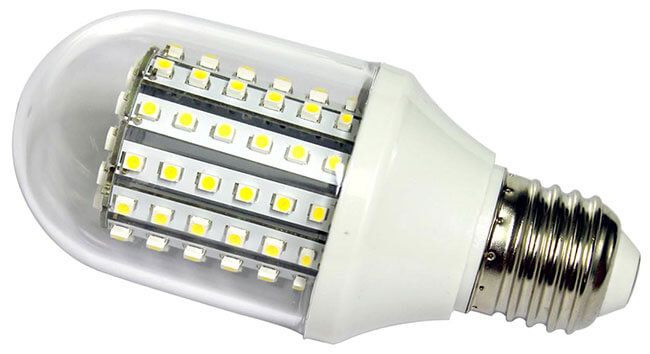
Ripple
Poor quality lamps pulsate strongly, this absolutely should not happen. The fact is that during pulsation, the light from such a bulb blinks. The human eye cannot recognize this flicker, but it acts as an irritant that affects nervous system, as a result of which a person begins to quickly get tired and experience irritability.
In order to identify such a defect, it is enough to point a cell phone camera at the lamp. If the image blinks, it means that such products are not worth buying.
Manufacturer
In stores you can find LED lamps, both from well-known manufacturers and from unfamiliar companies. In order to choose the best quality light bulbs, you should pay attention to the manufacturer’s profile. The best LED lamps for the home, the ratings of which are easy to compile yourself, will meet all requirements and have a warranty period.
If a company is engaged in tailoring, then most likely it is not able to offer high-quality lighting elements. It is best to choose brands that specialize in electrical and lighting equipment. The following manufacturers have proven themselves well:
- Philips;
- CREE;
- OSRAM;
- GAUSS;
- Nichia;
- LED Engine.
By choosing products from one of these companies, you can be sure that LED lamps will last a long time. Of course, the cost of lighting elements from world-famous manufacturers will be higher, but if you take into account that such a light bulb will have to be changed no earlier than after 5 years, then the savings are obvious.
Radiator
The presence of a radiator for LED lamps is mandatory, so you should refrain from purchasing models without it. Some manufacturers use a trick and install a plastic outlet in the lamps, which, in fact, does not perform a cooling function. Plastic will not last long, and the cooling efficiency of this material is much lower than that of aluminum. Such LED lamps for the home, reviews of which can be found on the Internet, quickly fail.
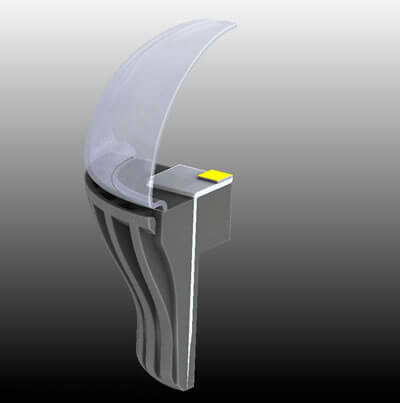
It is worth noting that frosted lamps do not allow you to determine the presence of a radiator, so it is better to give preference to opaque devices in which you can see all the elements.
Work resource
When choosing an LED lamp, you should definitely pay attention to the working resource. This characteristic will allow you to determine how many hours the lighting element can work. Today, manufacturers have achieved that this figure is up to 50,000 hours, which in turn is 15 years. You should not trust such information, since, even taking into account technological progress and other factors, LEDs change over time and begin to work worse.

Better to focus on guarantee period lamps, which ranges from 3 to 5 years. Based on this information, you can determine how long the light bulb will actually last.
Energy-saving or LED lamps, which is better?
To answer this question, it is enough to provide just a few numbers. LED light bulbs consume 3 times less electricity than energy-saving or fluorescent ones, even when taking into account the same luminous flux.
In addition to saving money, LEDs do not heat up and work excellently at low temperatures. These lamps do not contain hazardous substances such as mercury.
In custody
If we compare the characteristics of LED lamps for the home and conventional lighting elements, the former have more advantages. Today, LED devices can significantly save on electricity. In addition, LED lamps are the most environmentally friendly light sources.
Choosing such light bulbs is a rather tedious process, but important. It is not necessary to choose the most expensive lamps or, conversely, to chase the cheapest; you can always find a middle ground.
2.8571428571429 Rating 2.86 (7 votes)




